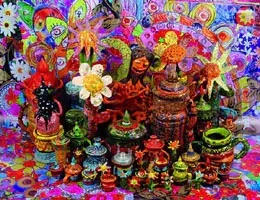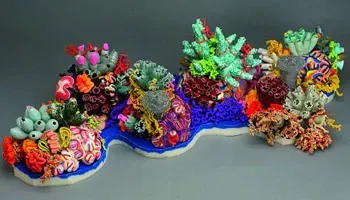Southern artists scoop ceramic awards
Written by

Dunedin artists took centre-stage at this year’s Portage Ceramic Awards, winning the premier prize with two large-scale, colour-infused works described by the internationally selected Awards’ judge as ambitious in concept, form and materiality.
Acclaimed ceramic artist Jim Cooper shared the country’s top ceramic award with Madeleine Child and Philip Jarvis who are known for their distinctively coloured works.
The prize money of $12,000 was presented to Cooper for his work Drug Jars and Vendor and Child and Jarvis for their work Doodads & Doodahs and Widespread Occurrence of Possible Symbioses at a ceremony held in Auckland last night.
This year’s Portage Ceramic Awards judge Scott Chamberlin, a successful exhibiting ceramicist and Professor of Ceramics at Colorado University, said Cooper’s work was unafraid of ceramic orthodoxy and genuinely bold in its pseudo primitiveness handling of clay.
"Beholden to the material lushness and glassy, flowing gooeyness of the medium, Cooper’s work is a feast for the eyes."
Chamberlin said Child and Jarvis’ work showed extraordinary observation skills which raised wonderful questions about nature versus culture and pays homage to various disciplines of decoration and ornamentation.
"The work is creepy, peculiar, and also possessing of a stunning beauty much like some of the natural occurrence it is inspired by. One sees a respect for and deep knowledge of ceramic processes."
Also announced were the three Portage Ceramic Awards Merit Winners, Phillipa Durkin (Wellington) for Felling the Tree to Obtain the Fruit, Kristy Palleson (Wellington) for Banks and Emily Siddell (Sandringham, Auckland) for her work, Flock.
West-Aucklanders John Parker, Sang Sool Shim & Keum Sun Lee were jointly awarded the John Green Waitakere Artist Award.
The winners were chosen from almost 200 works submitted by artists nationwide, a record number of entries in the Awards nine-year history.
Chamberlin points out that while the winning works and those selected for exhibition could compete anywhere in the world with confidence, the overall quality of the entries was of concern.
"The majority of the works submitted need to be more contemporary; artists need to take more risks."
There are fewer exhibiting pieces this year; just 29 compared to almost 50 in previous years.
These works, which include the winning pieces, can be viewed at Lopdell House Gallery from 16 October.
Madeleine Child and Philip Jarvis came to the New Zealand ceramics community via Mexico following study in London's Royal College of Art. They have an established reputation both internationally and nationally for their playful sculptural, multi-media practice. Their work is held in numerous collections including AIR Vallauris - France, Museum het Princessehof, Leeuwarden - The Netherlands, Frans Hals Museum - The Netherlands, Shepparton Art Gallery- Australia, Dowse Art Museum - Lower Hutt, Otago Museum, Auckland Museum and Canterbury Museum.
Doodads and Doodahs and Widespread Occurrence of Possible Symbioses - artist’s statement:
Two subjects, connected by a fascination with nature’s enviable ability to co-achieve efficiency and equilibrium. The complex partnerships and associations of marine life offer a way of working with dissimilar materials in intimate, symbiotic association: masses of tied and twisted rubber bands, paint-saturated sponge and ceramic polyps, pottery and its packing materials. Doodads & doodahs, oversized knick-knacks in a tradition of ornament and embedded decoration; thrown forms that just seem to happen when you are trying to think what to make on the wheel. Coral formed from obsessive compulsive nervous fiddling.
These works are about working with the not obviously beautiful – the almost ugly things that demand study and reward closer inspection. Thinking about them is to think about bothering to evolve ways to survive in a place (why not just move down the mountain?), about living in Dunedin, about identifying with this preoccupation with cold and damp.
There are recurring themes about things that come with their own funniness, such as popcorn, polyps, grey matter or vegetable sheep. They offer some sort of organic fecundity that is right for clay, because it is mostly poked and pushed or grabbed and squeezed. You always seem to be making a negative or a positive: female or male; a vessel or not.
Jim Cooper was born in Westport in 1956 and has a MFA Degree from Otago Polytechnic’s School of Art. He first began working with clay, making domestic pottery, in the early 1980s and taught himself the basics of working with earthenware, stoneware, raku and salt glazes. In 1993 Cooper was the joint winner of the Scotwood Award at the Cleveland Ceramics Awards in the United States and he was a finalist in the XPO New Zealand Ceramics and Glass Awards in Auckland in 1996. The following year a Creative New Zealand grant made it possible for Cooper to mount his first major individual show at the Dowse Art Museum in Lower Hutt. Since then he has participated in group and solo exhibitions throughout New Zealand.
Cooper, who until recently taught ceramics at Otago Polytechnic, won the premier prize at the Norsewear Art Awards in 2006.
Drug Jars and Vendor - artist’s statement:
I’ve been impressed with psychedelic record covers since forever. Michael Cooper’s Sgt Peppers photos, Martin Sharp’s Disraeli Gears etc. all that wonderful opulent bunching of colours and objects. My studio is like that – great corners, areas of carnage, colour and junk. I unload the kiln. The work teams up. It’s a random gathering… a slither or slice. Like looking at a painting and finding that nice area. That’s what this is – a nice area.
Work piles up in the studio. Pieces couple with other pieces or stand alone. This grouping is from a series of Turkish drug jars. The work is coil built and fired to cone 6. I’ve been working on a series of vessels for the last two months as part of another project.
I’ve always been a believer in the myth the urban legend and the way life could have been if the gods of fortune had smiled a little wider or at least wide enough to dispel some of life’s grim realities… and then there is the way memory enhances casual glances, the way small understandings are embroidered and loose associations are gathered together all far from a “news at 6” common consensus of reality and further still from a shared understanding of past…
I have always liked it best when the wind blows.
